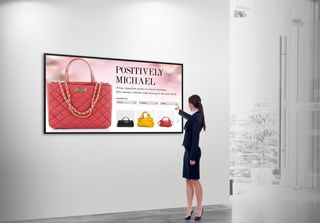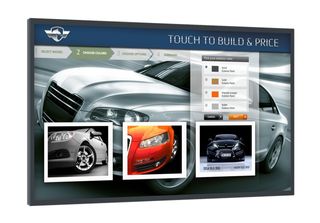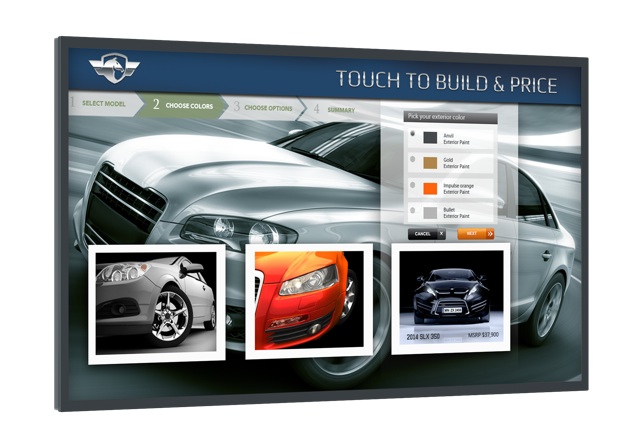As I strolled the halls of the Digital Signage Expo in Las Vegas this week, one fact was as clear as an image on a 4K display: digital signage is much more than a digital sign. Once an identifiable category, digital signage has become more expansive and inclusive. Digital signage means geo-fencing, motion sensor triggers, UDP controls, IP streaming, push to smartphones, analytics, multipurpose applications, channel creation, and networking. When I asked X20's CEO David Wilkins what digital signage in 2014 is really about, he said simply: "communications."

Planar's Ultra Res Touch featuring Corning Gorilla Glass.
At DSE '14, I was fortunate to see a panoply of products that support the next level of real-time communications. Here are my DSE take-aways and trends worth noting:
• 4K Evolves
"4K is the normal evolution from 1080p," said Bill Taylor, director, Global Signage at CoolSign, a Haivision brand. While it's still in its nascent stages in commercial vertical applications, more manufacturers are offering graphics cards, hardware solutions, and encoding for 4K content. BrightSign is offering native 4K playback at 3840 x 2160 resolution, H.265 via HDMI 2.0 at 60 fps.
Medical, command and control, military, and retail applications where "ultra rez" makes a different (e.g., Lexus or high-fashion retailers), see the benefit of moving to 4K. Hardware prices should drop in time — but it isn't clear when, exactly.
Sharp is the only company that's currently offering 4K in a 32-inch form factor. It's also partnering with Apple to showcase the 32-inch models in Apple Stores.
Planar is making headlines at DSE with its 84-inch 4K Planar UltraRes Touch with extended ruggedness and optics (ERO) and more touch points.
Becky Connors, Planar Systems' product marketing manager, stated: “By dramatically increasing the number of touch points, we’ve made it possible for organizations to create highly immersive and engaging experiences.” Also notable about this Planar unit is that it features Corning Gorilla Glass which gives it a more durable, scratch-resistant cover.
- Commercial 4k content is driving the market, and if manufacturers can reduce the price of the display, other components in the chain (e.g., encoding, graphics cards, etc) should also come down.
- "Our goal is to bring it [4K] to the mainstream," Kevin Schroll, senior product marketing manager of Samsung, said. "It is an evolution, like 1080p was a few years ago."
Schroll also noted that investing in 4K hardware will benefit users with 1080p content due to the significant increase in pixel density. Not enough attention has been paid to the fact that "4K hardware will make 1080p content pop," he added.
For the fiber-friendly, Gefen's 4K Ultra HD extender moves HDMI 4K over fiber. The solution delivers resolutions up to 3840 x 2160 at 30Hz with RS-232 and bi-directional IR using one SC-terminated fiber optic cable. It's effective up to 2,000 meters.
• Hybridization of Local Content and Streaming Content
Local, pre-produced content, live feeds, and multiple media streams are nesting in one display. More users are requesting the integration and nesting of PTZ or high-res security camera feeds, emergency alerts, campus police triggers, Excel files, productivity work flows, pre-made content, and more, in their signage screens. It's a more functional version of PIP (picture in picture). Not only that, tech managers are looking for the ability to network, control, and monitor screen content in real time.
X20 offers a different method of integrating and managing hybrid feeds: SharePoint TV is a unique approach for corporate-wide visual communications and customizable channels. It's drag-and-drop channel building; imagine a much more agile enterprise-grade dashboard with a customizable UI. SharePoint TV is a fascinating amalgam — digital signage plus corporate video plus unified communications, all in one.
• Open Standards
Even as questions swirl about H.264 vs H.265, manufacturers are laying claim to products that are "future proofed." This was clear at the Matrox booth. Samuel Recine of Matrox said that the company is democratizing H.264 encoders to work over a standard network. In turn, users won't need special collaborative tools for real-time content sharing. Streams from the Maevex product can be picked up by any user — operator to operator, device to device. Maevox streams are free to decode. "When someone asks us what they can do to future-proof, we say move from proprietary to open, and from baseband to IP," Recine explained.
When it comes to H.265, don't wait for the perfect product to materialize. Recine said that investing in a solid "open standard" system now will offer reliable performance, even as platforms evolve.
• Interactivity & Collaboration
Interactivity in digital signage can enhance and customize a 1:1 user experience. Retailers are using live Twitter, Flickr, and other rich media feeds in concert with touch interactivity to increase customer engagement. Sports arenas are using geo-fencing to play content targeted in the user's current location. Higher ed, hospitality, museum, healthcare, and business technology managers are using touch interactivity for wayfinding, education, and entertainment in BYOD environments.
Samsung debuted its D Series this week. It's not only the next generation of the company's Smart Signage Platform, it includes a bevy of significant upgrades, including All Share for real-time collaboration, powerful processing with its QuadCore chip, and enhanced touch interactivity. By eliminating the need for external media players, Samsung says that the Smart Series can reduce the total cost of ownership "up to 40 percent over three years for small- and medium-sized digital signage networks."
It's easy to forget that interactivity also means audio as well as visuals and touch, that's why Parametric Sound used the DSE stage to showcase its HyperSound solutions. HyperSound uses directed audio playback to enhance digital signage kiosks, retail, and tradeshow spaces with directional yet "3D sound."

• End-to-end encryption
As mentioned earlier, a trend in digital signage is the integration of live video feeds. But live feeds — especially government content — must be encrypted and content-protected. Security cameras, lecture capture, and court proceedings must all be secure. Toward that goal, Haivision is offering 256-bit AES end-to-end encryption.
• Networking
For CradlePoint, key to a successfully deployed digital signage systems is reliable network connectivity that doesn't drop off intermittently. "While much of the focus of digital signage design and implementation is on user interface, efficient data retrieval, delivery and presentation, more recently a highly reliable and consistent network connection has become integral to the success or failure of DOOH signage solutions," the company stated. The company tackles these back-end issues in their new portfolio of integrated solutions for distributed cloud management and analytics.
The MediaCento from BlackBox now offers USB HID support for touchscreens and other USB human interface devices. These appliances can be used in unicast or multicast applications; transmitters will also send USB signals to one receiver. MediaCento USB streams HD video over IP, sending HDMI video and audio to any number of screens on a network. Transmitters and receivers can install directly into your existing LAN infrastructure; it will transmits up to 330 feet over CATx cabling. Signals will go farther when networks switches with IGMP snooping are placed between the transmitter and receiver.
• Multiple Displays
General flat-panel prices continue to drop, therefore multiple display configurations are growing in popularity: digital menu boards, matrix walls in 3x3, and similar configurations of multiple screens. With prices starting at $595, the Planar Simplicity Series extends the benefits of digital signage to more organizations and facilities with limited budgets. The Simplicity Series also offers the full suite of inputs and can be controlled remotely (via LAN or RS-232).
The 55-inch TH-55LFV50 direct-lit LED display from Panasonic features an ultra-narrow bezel. While there is a surfeit of slim-bezel designs at the show, with 800 cd/m2 brightness, this Panasonic model lends itself to video wall arrays, digital signage, Help Desk/public info stations, and command/control applications.
As more displays are getting installed in more locations, how do mounts and brackets fit into the equation? Karen Mefford, director of marketing at Chief, said that the new ConnexSys Video Wall mounting system was created, in part, from crowd-sourced feedback from users and dealers. "We wanted to know what the main 'pain points' were." The Chief team discovered that display alignment post-installation was a source of frustration. That's why Chief added six points of adjustment and lateral shift to the micro-adjustable ConnexSys. The structure offers a 'power zone' on the top, "adjustment with no fear of damaging the screen," and more options for easy cable access/maintenance. For example, tech managers and installers can level each row once by using strut channels.
Crimson AV used the DSE spotlight to showcase its newly redesigned CML and CMP ceiling-mounted menu board mount system. The mount solution is modular for mounting multiple displays from the ceiling — in landscape or portrait view — and features Crimson’s "simplified alignment design and post-installation leveling," the company said.If you are in the market for a video wall, but you're confused about your options, related fees, and designs, check out Premier Mounts’ Video Wall Solutions Training Center. It's a full-scale, fully interactive training tool that demonstrates all the methods of integrating a video wall into a structure—including on the wall, in the wall, floor, ceiling, and curved video wall. The VWSC lets you review options and work with physical comparisons of those options, prior to making a decision.
• Mainstream Acceptance
From subway station kiosks to Twitter walls to the large-screen deployments in airports and sports facilities, digital signage has become a common feature of our shared environment. A great example of this in NYC's Grand Central Station. 18 digital maps have been installed at one of New York City's most famous transport hubs, as reported by Mashable. 47-inch touchscreen kiosks will display departures, arrivals, delays and outages, as well points of interest. Mashable stated: "The MTA awarded the contract to install these interactive maps to technology and design firm Control Group, with the key goal of helping riders better learn the subway system. Control Group began by studying subway riders and their use of maps for one month. From these observations, it created three categories: seasoned riders, commuters going somewhere other than their normal route, and visitors."
And, finally, keep your eyes on how Google and Apple are influencing this arena. Prominent companies with efficiencies in other markets are jumping into digital signage, and with good reason. As Frederic Lardinois at Tech Crunch reported, "Google is highlighting how Chromeboxes can power — you guessed it — digital signage."
Margot Douaihy is the editor of AV Technology magazine and EDUwire.com. She is an EdTech advisor and has taught at Marywood University in Scranton, PA.











